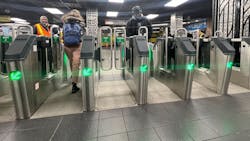MTA making progress on combating fare evasion on subways systems
The Metropolitan Transportation Authority (MTA) has made progress on combating fare evasion on its subways systems since the Blue Ribbon Panel on Fare Evasion issued a report outlining ways to reduce fare evasion in 2023. Convened in the spring of 2022, the Blue-Ribbon Panel, consisting of education, social justice, business and law enforcement experts, was given a mandate to investigate the root causes of fare and toll evasion and develop a comprehensive strategy to combat it.
According to the 2023 report, the situation had reached crisis levels, with the MTA losing an estimated $690 million in unpaid fares and tolls in 2022, threatening the economics of mass transit in the New York metropolitan area and tearing at the social fabric of the city and region. To drive down evasion, the panel proposed a refreshed, 360-degree strategy, which moved away from a sole focus on enforcement and instead, responded to the root causes of fare and toll evasion through the four “E’s” of Education, Equity, Environment and Enforcement.
“The MTA recognizes fare evasion is an existential challenge,” said MTA Chair and CEO Janno Lieber. “We understand that this is a complex issue without a one-size-fits-all solution – there are fare evaders who are determined not to pay, those who would have otherwise but see an opportunity and some who might struggle with affordability fares. These all require their own solutions – in the immediate term that means starting out with enforcing the fare immediately while making sure people are aware of resources that can help those who are truly in need. It means communicating to riders why it's so important to pay the fare and it means changing the physical fare control area in the short-term and rethinking it for the long-term.”
Initiatives the MTA has pursued in the past year
Education and equity
- Equity at the forefront: The MTA has created 15 Customer Service Centers that will be integrated with enrollment in Fair Fares, the city of New York’s program to provide eligible New Yorkers with half-fare MetroCards and OMNY accounts. The MTA has expanded marketing for Fair Fares across the subway and buses.
- Students: The MTA is launching a student rewards program to encourage student MetroCard usage this spring and is coordinating with the New York City Department of Education to focus on student fare compliance during the transition away from MetroCard during the 2024-2025 school year.
Strategic deployment of enforcement
- New York Police Department collaboration: Police officers have doubled their enforcement activity, issuing 43,000 summonses adjudicable by the Transit Adjudication Board in 2024 through Week 18, a 50 percent increase during the same time period in 2019.
- Gate guards: The MTA has deployed unarmed gate guards at 50 subway stations. In the initial targeted stations with guards or delayed egress, MTA estimates a 20 to 30 percent decrease in fare evasion levels. New York City Transit has committed to increasing the number of gate guards, with approximately 40 additional gate guards added each week towards the goal of 1,000 in the system. Gate guards are deployed based on data on the frequency and prevalence of fare evasion.
Improving the fare control environment
- Turnstile modifications: The MTA has taken steps to tackle evasion tactics at the turnstiles. The MTA upgraded 1,400 turnstiles at more than 100 stations to prevent back-cocking and is on target to reach the goal of modifications at 60 percent of turnstiles by the end of 2024. Turnstiles with those modifications have seen an 80 percent reduction in back-cocking. The authority also installed turnstile fins at four pilot stations, observing a decrease in jumping by more than 20 percent at these fare control areas. The MTA plans to roll out fins at 10 more stations during the upcoming months.
- Time-delay emergency exit pilot: The MTA piloted delaying the opening of emergency exit gates by 15-seconds at three stations and observed a 38 percent decrease in evasion through the gate and a seven percent decrease in evasion overall at those fare control areas. The MTA is expanding the delayed egress pilot at new stations during the upcoming months and launching a system-wide study to analyze stations and implement delayed egress where it is safe to do so.
- Modern fare gates: The MTA replaced traditional emergency exit gates with new, accessible wide-aisle gates at Atlantic Avenue-Barclays Center, 34 St. A, C, E Astoria Blvd N, W and introduced a new full array at Sutphin Blvd-Archer Avenue E, J, Z, where fare payment increased by 20 percent compared to 2023. The MTA is expanding the pilot – with improved design features like higher paddles and more sophisticated sensors – to at least 15 stations in 2024.
The first 10 stations are:
- 42 St.-Port Authority Bus Terminal A, C, E
- 125 St. 2, 3
- 149 St-3 Ave. 2, 5
- Bowling Green 4, 5
- Crown Heights-Utica Avenue 3, 4
- Delancey St-Essex Street F, J, M Z
- E 180 St. 2, 5
- Flushing-Main Street 7
- Forest Hills-71 Ave. E, F, M, R
- Kingsbridge Road B, D
Long-term investments
The new fare gates are a first step towards modernizing the fare control area. In December 2023, the MTA released a Request for Information (RFI) to qualify the next generation of secure, accessible and modern fare gates. After receiving and evaluating 12 responses from gate vendors, the MTA will begin in-lab testing of promising gate technology in summer 2024 and in-system testing in 2025.
The MTA is launching a Fare Evasion Lab as a test bed for new fare compliance technologies, including modern fare gates that will be evaluated as part of the MTA's RFI.
